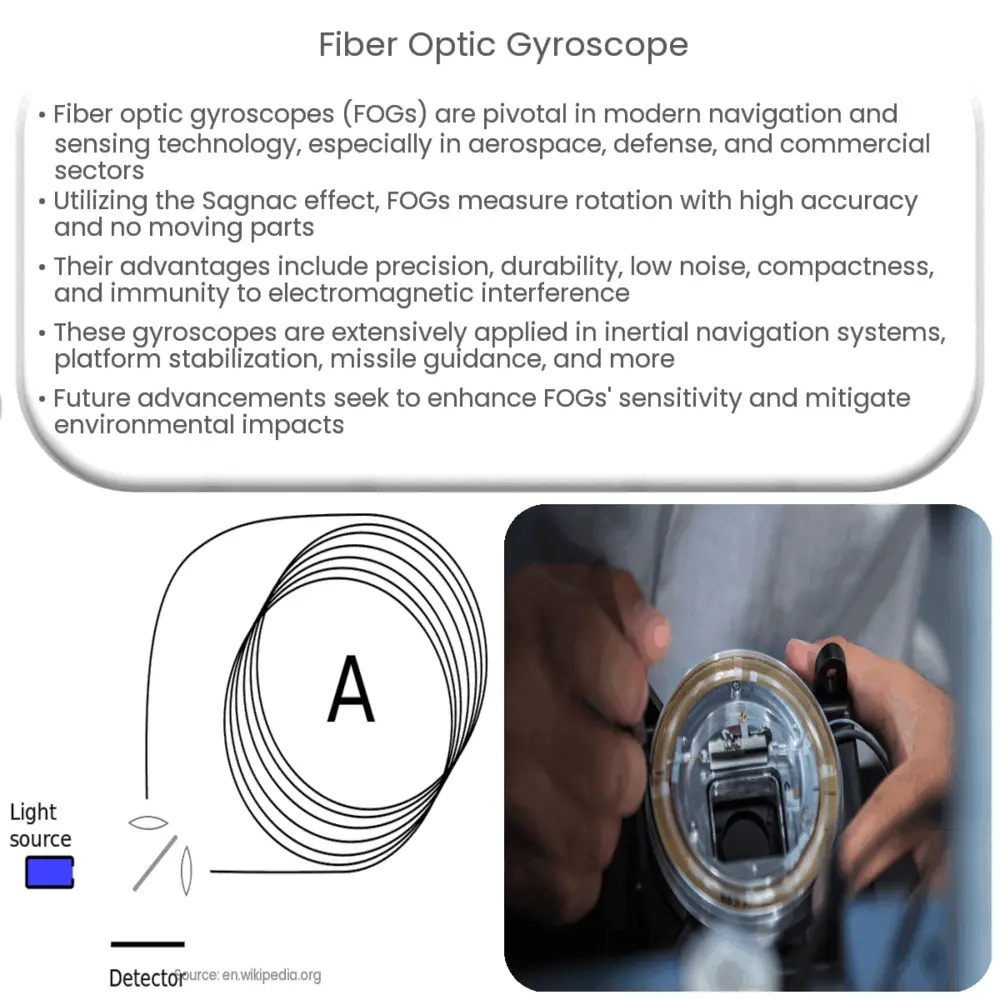Fiber optic gyroscopes provide accurate rotation measurements for navigation and sensing applications in aerospace, defense, and robotics.

Fiber Optic Gyroscope: A Revolution in Navigation and Sensing Technology
In recent years, the demand for precise, reliable, and efficient navigation and sensing systems has significantly increased due to the growing number of applications in aerospace, defense, and commercial sectors. One of the key components of these systems is the gyroscope, a device used to measure and maintain orientation and angular velocity. Among various types of gyroscopes, the fiber optic gyroscope (FOG) has gained substantial attention due to its numerous advantages over its counterparts. In this article, we explore the working principle, advantages, and applications of fiber optic gyroscopes.
Working Principle of Fiber Optic Gyroscope
The fiber optic gyroscope is an optical device that leverages the Sagnac effect, a phenomenon observed in interferometry, to measure rotation. The FOG consists of a spool of optical fiber, typically several kilometers long, wound around a central core. Light from a laser diode is split into two beams, which travel in opposite directions along the fiber loop. When the loop is stationary, the beams take an equal amount of time to complete their respective paths and recombine at the photodetector, resulting in an interference pattern with no net phase shift.
However, when the loop rotates, the path lengths for the two beams change relative to each other. This causes a difference in the time it takes for the beams to traverse the loop, resulting in a phase shift proportional to the angular velocity of rotation. By measuring this phase shift, the FOG can accurately determine the rate of rotation.
Advantages of Fiber Optic Gyroscope
Fiber optic gyroscopes offer several advantages over traditional mechanical and other solid-state gyroscopes, making them the preferred choice for a wide range of applications. Some of the key benefits of FOGs include:
- High Accuracy: FOGs provide extremely accurate measurements of angular velocity, with minimal drift over time. This makes them ideal for high-precision applications such as inertial navigation systems and platform stabilization.
- No Moving Parts: Unlike mechanical gyroscopes, FOGs have no moving parts, reducing the risk of mechanical failure and wear. This results in increased reliability, longer lifespans, and reduced maintenance requirements.
- Low Noise: Fiber optic gyroscopes exhibit low noise characteristics, allowing for highly sensitive and accurate measurements in challenging environments.
- Compact and Lightweight: Due to the use of optical fibers, FOGs can be designed with small form factors and low weight, making them suitable for applications with strict size and weight constraints, such as satellites and unmanned aerial vehicles.
- Immunity to Electromagnetic Interference: FOGs are inherently immune to electromagnetic interference, enabling their use in environments with high electromagnetic noise levels, such as near motors and power lines.
Applications of Fiber Optic Gyroscope
Due to their numerous advantages, fiber optic gyroscopes have found applications across a wide range of industries, including aerospace, defense, and commercial sectors. Some of the key applications of FOGs are:
- Inertial Navigation Systems: FOGs are widely used in inertial navigation systems (INS) for aircraft, ships, and land vehicles, providing accurate and reliable attitude, heading, and position information.
- Platform Stabilization: Fiber optic gyroscopes are used to stabilize platforms such as cameras, telescopes, and antennas, ensuring precise pointing and tracking in dynamic environments.
- Missile Guidance: Due to their high accuracy and immunity to electromagnetic interference, FOGs are often employed in missile guidance systems, providing reliable navigation and control during flight.
- Space Applications: FOGs are used in spacecraft for attitude control and orbit determination, as well as in satellite-based systems for Earth observation and communication.
- Robotics and Autonomous Vehicles: Fiber optic gyroscopes are increasingly being integrated into robotics and autonomous vehicle systems to provide accurate navigation and stability information, enabling precise movement and control.
- Industrial Applications: FOGs are utilized in various industrial applications, such as monitoring and controlling the orientation of drilling equipment in the oil and gas industry, and providing accurate positioning data for geophysical surveys.
Future Developments and Challenges
As technology continues to advance, the demand for even higher performance fiber optic gyroscopes is expected to grow. Researchers and manufacturers are exploring new materials, such as photonic crystal fibers and hollow-core fibers, which have the potential to further improve the accuracy and sensitivity of FOGs. Additionally, advances in integrated photonics and microfabrication technologies may lead to the development of chip-scale FOGs, offering further reductions in size, weight, and cost.
Despite their numerous advantages, fiber optic gyroscopes still face several challenges. One of the main limitations of FOGs is their sensitivity to environmental factors such as temperature, humidity, and vibration. Efforts are ongoing to develop advanced compensation algorithms and robust packaging techniques to mitigate these effects and further improve the performance of FOGs in demanding environments.
Conclusion
Fiber optic gyroscopes have revolutionized the field of navigation and sensing technology, offering numerous advantages over traditional mechanical and solid-state gyroscopes. With their high accuracy, reliability, and immunity to electromagnetic interference, FOGs have found applications in various industries, from aerospace and defense to robotics and industrial processes. As research and development efforts continue, the future of fiber optic gyroscope technology promises further improvements in performance, enabling even more advanced and diverse applications.

